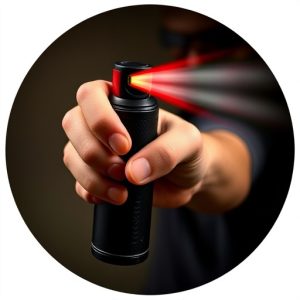Mastering Pepper Spray Safety: Storage, Legalities, & Alternatives
Storing pepper spray at home requires careful consideration for safety. Keep it in a cool, dry place…….
Storing pepper spray at home requires careful consideration for safety. Keep it in a cool, dry place away from direct sunlight and out of reach of children or unauthorized individuals. Regularly check expiration dates and dispose of outdated cans responsibly. Understand local laws regarding pepper spray usage before purchasing. Explore alternatives like sound, light, or capsaicin devices for safer personal protection to avoid risks associated with storing pepper spray at home.
“Discover the power of non-lethal inflammatory self-defense tools, particularly pepper spray, in this comprehensive guide. We’ll explore its composition, effectiveness, and how it can be a vital personal safety measure. Learn about responsible storing of pepper spray at home through best practices tailored for optimal security. Dive into legal considerations to understand its use within the boundaries of the law. Additionally, we’ll uncover alternatives to pepper spray, offering a range of non-lethal options for self-defense.”
- Understanding Pepper Spray: Composition and Effectiveness
- Storing Pepper Spray Safely at Home: Best Practices
- Legal Considerations: Using Pepper Spray for Self-Defense
- Alternatives to Pepper Spray: Exploring Non-Lethal Options
Understanding Pepper Spray: Composition and Effectiveness
Pepper spray, a non-lethal inflammatory self-defense tool, is designed to incapacitate an assailant temporarily by causing irritancy and pain. Its primary active ingredient is capsaicin, derived from chili peppers, which is known for its pungent properties. When sprayed, capsaicin comes into contact with the eyes, skin, and respiratory system, leading to temporary blindness, difficulty breathing, and intense pain. This reaction gives the user time to escape or defend themselves further.
Proper storage of pepper spray at home is crucial for safety and effectiveness. It should be kept in a cool, dry place away from direct sunlight. Ensuring it’s out of reach of children and unauthorized individuals is vital. Additionally, checking the expiration date regularly and replacing the spray as needed are essential maintenance practices. Storing pepper spray responsibly enhances its readiness when needed, ensuring its ongoing effectiveness as a self-defense mechanism.
Storing Pepper Spray Safely at Home: Best Practices
When storing pepper spray at home, safety should be your top priority. Keep it out of reach of children and anyone who might misuse it. A locked cabinet or safe is ideal for securing your pepper spray, ensuring it’s protected from curious hands and accidental discharge. Choose a cool, dry place away from direct sunlight to prevent the spray from becoming contaminated or losing its potency.
Remember that proper ventilation is crucial to maintaining the effectiveness of the spray. Avoid storing it in enclosed spaces like closets or storage areas without adequate airflow. Regularly check the expiration date and condition of your pepper spray, disposing of it safely when needed. Always keep it in its original packaging with all labels intact for easy reference and safety instructions.
Legal Considerations: Using Pepper Spray for Self-Defense
When considering pepper spray as a self-defense tool, understanding legal considerations is paramount. In many jurisdictions, citizens are allowed to carry and use pepper spray for personal protection, provided they comply with specific laws and regulations. These rules vary widely by region, so it’s essential to research and understand the local laws before purchasing or using any form of self-defense spray.
Storing pepper spray at home also requires caution. It’s crucial to keep it out of reach of children and unauthorized individuals. Many states have specific guidelines regarding storage, often recommending secure lockable containers. Always follow manufacturer instructions for proper storage and disposal to ensure the safety of yourself and your surroundings.
Alternatives to Pepper Spray: Exploring Non-Lethal Options
In many situations, pepper spray has been the go-to non-lethal self-defense tool for individuals seeking to protect themselves from potential threats. However, there are valid concerns around its storage and use at home, particularly in households with children or pets. Storing pepper spray requires careful consideration to ensure it’s out of reach and secure to prevent accidental discharge. Alternatives to pepper spray offer a promising exploration for those looking for non-lethal options with reduced risks associated with chemical irritants.
These alternatives include devices that use sound, light, or even capsaicin in a less concentrated form. For instance, personal alarm devices that emit loud sounds and flashing lights can deter attackers without causing lasting harm. Some options utilize natural substances like capsaicin gel, which is found in chili peppers, to provide a temporary sting without the same level of irritation as pepper spray. By considering these non-lethal inflammatory self-defense tools, individuals can better protect themselves while mitigating the risks and responsibilities associated with storing chemical irritants at home.
In conclusion, while pepper spray offers a valuable non-lethal inflammatory self-defense tool, proper storage at home is paramount for safety and legal compliance. Understanding its composition, effectiveness, and legal considerations, alongside exploring alternatives, equips individuals to make informed decisions. By adhering to best practices for storing pepper spray at home, users can ensure their safety and peace of mind while navigating potential threats in today’s world.


